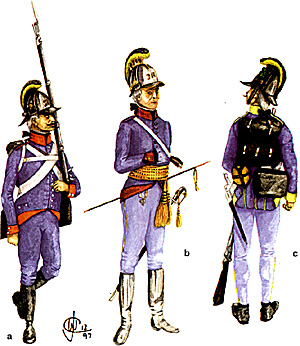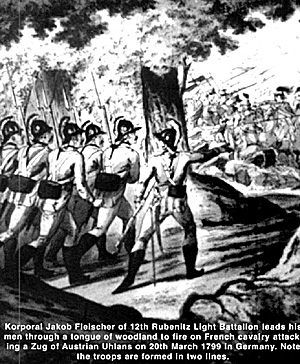
Now that the bicentennials of the War of the First Coalition are over, aside from any brave soul off to ride a camel in Egypt, we can now look forward to rerunning the War of the Second Coalition. Contrary to what has appeared in many places, the Austrians set about a thorough overhaul of their forces in 1798, especially its weaponry.
Light Infantrymen: a) 3rd Battalion in a proper uniform with German cuffs, b) 9th battalion officer In a Hungarian sytle uniform and blue trousers, and c) 13th battalion man also in blue trousers.
Like the French, they were also keen to keep more order amongst the wilder elements of their forces. Austria had hastily raised many Freikorps units (volunteers) for the First Coalition, which were regularised in 1798, the plan being to create 15 regular Light Infantry Battalions. There wasn't enough space to include them in my MAA299 for Osprey on the various non-Line units, but Haythornthwaite's muddled essay in the July 1997 Military Illustrated makes it clear that this subject is still poorly understood. So, this is intended as a guide to the light units during the Second Coalition.
I am not aware of any specific drill regulations for the Light Infantry Battalions, so there appears to be an ad-hoc use of Line regulations and as was the case with the Grenzer, in a simpler version. The subject of their tactics also needs extensive examination, but considerably more work needs to be done first, so this item is confined to uniforms and organisation, albeit it also reveals some of the problems of the multi-ethnic nature of the Austrian Army.
Paintbrush at the ready, John Cook has kindly illustrated this item and thanks to Peter Hofschroer and Ian Castle for b/w pictures.
More Austrian Light Infantry 1799-1801 by Dave Hollins
 Some of the political/geographical background is less riveting than the battles contested, but any assessment of these troops must be based on that before it is possible to
get to grips with their combat capabilities. Situated in central Europe, Austria like the Roman god Janus, had to look in two very different directions at once. To the west were the
European nations, from where Austria drew her Germanic South Netherlands and Northern Italian
troops; to the south were the wilder tribes of the Balkans, whose interminable troubles also
produced waves of refugees and new soldiers used to small scale fighting in difficult terrain. In addition, the acquisitions of territories in southern Poland provided additional irregular troops.
Some of the political/geographical background is less riveting than the battles contested, but any assessment of these troops must be based on that before it is possible to
get to grips with their combat capabilities. Situated in central Europe, Austria like the Roman god Janus, had to look in two very different directions at once. To the west were the
European nations, from where Austria drew her Germanic South Netherlands and Northern Italian
troops; to the south were the wilder tribes of the Balkans, whose interminable troubles also
produced waves of refugees and new soldiers used to small scale fighting in difficult terrain. In addition, the acquisitions of territories in southern Poland provided additional irregular troops.
Background
Grenz and Other Regiments
FreiKorps, Jagers, and Balkan Units
Illustrations (slow: 121K)
Chart of Battalions
Back to Age of Napoleon 26 Table of Contents
Back to Age of Napoleon List of Issues
Back to MagWeb Master List of Magazines
© Copyright 1998 by Partizan Press.
This article appears in MagWeb (Magazine Web) on the Internet World Wide Web.
Other military history articles and gaming articles are available at http://www.magweb.com